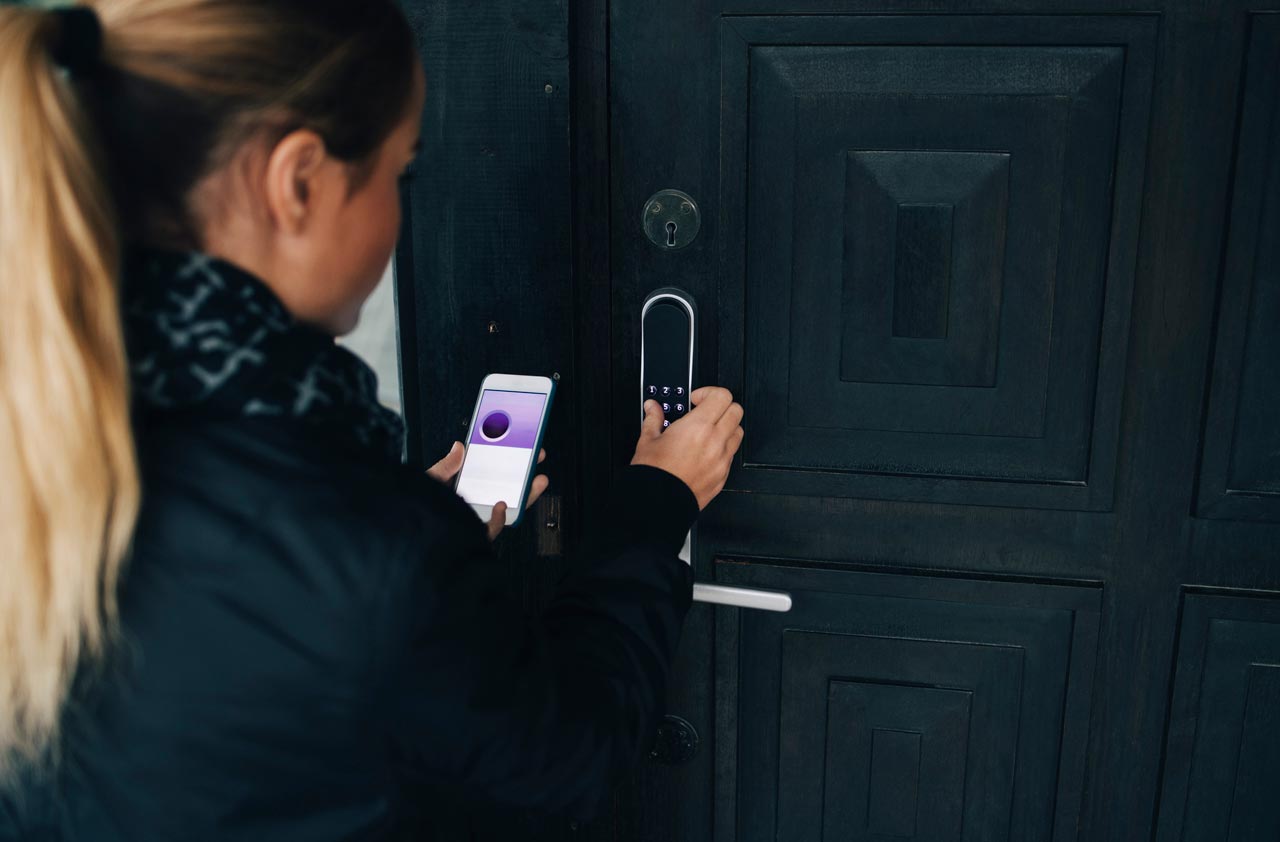Finding a Smart Lock That Clicks for You
Lock and unlock your door with your smartphone, no matter where you are.


Smart locks are slowly becoming a smart-home staple. Install one of these devices on your entry door and you’ll be able to lock and unlock the door with a smartphone app or a keypad. Some models lock and unlock the door automatically as you (and your smartphone) leave or approach the house. They’ll also allow you to check remotely to see whether the door is locked, as well as use a virtual assistant to lock the door. And some let you create a digital key for one-time use or for use during a specific time frame.
Key or no key?
Smart locks are available with a variety of features and in a plethora of styles, says Molly Price, associate editor of CNET.com. You can choose a lock that either works with the existing hardware or replaces it. Many smart locks don’t have a slot for a traditional key, but you may want one that does if you have a family member who isn’t comfortable with technology. Do-it-yourselfers can install smart locks on their own; professional installation will likely cost $50 to $200.
If you already have an Alexa or a Google Home smart speaker, you’ll want a lock that’s compatible with the system. Some smart locks have features that only work when your smartphone is within about 300 feet, but others allow you to check on the status of your lock from anywhere. To get a smart lock with the most-robust features, look for one that uses Wi-Fi—or comes with a hub that ties in to your Wi-Fi network—instead of relying only on Bluetooth.

Sign up for Kiplinger’s Free E-Newsletters
Profit and prosper with the best of expert advice on investing, taxes, retirement, personal finance and more - straight to your e-mail.
Profit and prosper with the best of expert advice - straight to your e-mail.
August’s Smart Lock Pro + Connect ($279) packs a lot of features into a small unit and gets strong reviews from CNET and other tech sites. The hockey-puck-shaped smart lock sits on top of the dead bolt you already have in your door. Use your key, or use the August app (which works with Apple and Android systems) to lock and unlock the door remotely, create virtual keys for others (by sending them an invitation to use the app), and see a list of who has used his or her smartphone to enter.
The lock also pairs with Alexa, Siri and Google Assistant, so you can trigger the lock with your voice. You can set the door to lock and unlock when you (and your smartphone) leave or return home. It can also be paired with August’s Doorbell Cam Pro ($199), which lets you see who’s at the door, and a keypad ($79), which lets you unlock the door without a key or a smartphone. The lock’s four AA batteries should last several months.
If you’re ready to ditch your key, consider Yale’s Real Living Assure Lock SL Key Free Touchscreen With Network Module ($219). The lock replaces your existing dead bolt with a slim touchscreen keypad outside and a box with a dead bolt and space for four AA batteries inside. You lock the door with a quick tap and unlock it by entering your four- to eight-digit code. Apple users can ask Siri to unlock the door, or they can use the Yale Secure app to lock and unlock the door remotely and manage up to 250 PIN codes. You can also control the lock with Alexa or via the Amazon Home app.
To minimize the possibility of giving a hacker access to your home, choose a smart lock from an established company that’s up front about its security and encryption policies. You’ll also want a lock that has received a rating of 1 or 2 from the American National Standards Institute, which grades locks on a scale of 1 (highest) to 3 (lowest) for physical strength and ability to withstand vandalism and heavy use. Also use a custom password on your home’s Wi-Fi network and your smartphone and run regular app updates.
Get Kiplinger Today newsletter — free
Profit and prosper with the best of Kiplinger's advice on investing, taxes, retirement, personal finance and much more. Delivered daily. Enter your email in the box and click Sign Me Up.

-
 The Best Energy Stocks to Buy
The Best Energy Stocks to BuyEnergy stocks can expose investors to volatile oil and gas prices. Here's how to find the best energy stocks to buy now.
-
 Warren Buffett to Step Down From Berkshire Hathaway
Warren Buffett to Step Down From Berkshire HathawayThe greatest investor of all time will step down as CEO of Berkshire Hathaway at the end of the year, but will still chair the company's board.
-
 How to Search For Foreclosures Near You: Best Websites for Listings
How to Search For Foreclosures Near You: Best Websites for ListingsMaking Your Money Last Searching for a foreclosed home? These top-rated foreclosure websites — including free, paid and government options — can help you find listings near you.
-
 Luxury Home Prices Rise as the Rich Dodge High Mortgage Rates
Luxury Home Prices Rise as the Rich Dodge High Mortgage RatesLuxury home prices rose 9% to the highest third-quarter level on record, Redfin reports, growing nearly three times faster than non-luxury prices.
-
 Four Tips for Renting Out Your Home on Airbnb
Four Tips for Renting Out Your Home on Airbnbreal estate Here's what you should know before listing your home on Airbnb.
-
 Five Ways to Shop for a Low Mortgage Rate
Five Ways to Shop for a Low Mortgage RateBecoming a Homeowner Mortgage rates are high this year, but you can still find an affordable loan with these tips.
-
 Looking to Relocate? Plan for Climate Change
Looking to Relocate? Plan for Climate Changebuying a home Extreme weather events are on the rise. If you’re moving, make sure your new home is protected from climate change disasters.
-
 Retirees, A Healthy Condo Has a Flush Reserve Fund
Retirees, A Healthy Condo Has a Flush Reserve FundSmart Buying Reserve funds for a third of homeowner and condo associations have insufficient cash, experts say. Here are some cautionary steps you should take.
-
 Cash Home Buyers: New Services Offer Help Making All-Cash Offers
Cash Home Buyers: New Services Offer Help Making All-Cash OffersBecoming a Homeowner Some firms help home buyers make all-cash offers on homes. Weigh the fees before you sign on.
-
 Home Sale Prices in the 50 Largest Metro Areas
Home Sale Prices in the 50 Largest Metro AreasBecoming a Homeowner What’s happening in the market where you live?